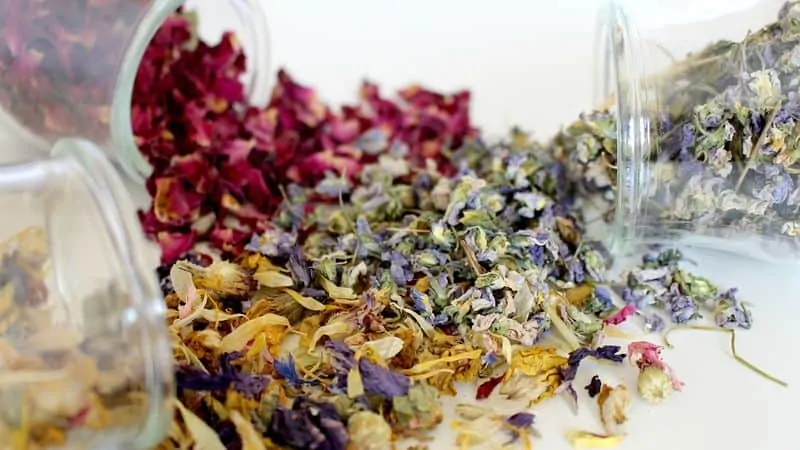 Plain water is so boring.
Plain water is so boring.
It also lacks the restorative, stress-busting and many other beneficial properties of a tea bath.
But you want to make sure you do it right.
Many of the commercial bath bombs you can buy contain unnecessary additives that are meant to give the water a nicer color or a pleasing fizz. But some are also unhealthy and can cause irritations in some people.
You are always best off learning how to make bath tea on your own. That way you can add exactly the herbs you need and keep out anything you don’t.
We’ll cover how to make an herbal tea bath (it’s simple) and some of the more popular ingredients, along with their primary health benefits.
That way you will know exactly what to include in your bath tea. As always, I highly encourage experimenting until you find the perfect mix for you.
We’ll get into all of that in a minute. First, a few more words on why it makes sense to cook up your own tea bath.
Table of Contents
The Power Of Bath Tea
We’ve all been guilty of spending twenty dollars or more at our favorite store that specializes in bath products. But are bath bombs really worth the high price tag?
Sure it’s pretty entertaining to watch the balls fizz up and dissolve, but in the end, they’re not going to provide the same type of results you’d get if you used fresher ingredients. And some can actually cause allergic reactions. That said, even green tea can cause allergic reactions, though it is exceedingly rare.
Making a bath using herbal tea can provide far better benefits, ranging from improved skin tone and texture to a reduction in pain and inflammation. Tea is just that powerful.
Taking an herbal bath can be a relaxing and simple way to wind down after a long day at the office.
Combining the soothing effects of hot water and the power of herbs lets relax while your body absorbs the important compounds from the plant through your skin. You enjoy many of the same health benefits you normally would from drinking your daily cup of herbal tea.
How To Make Bath Tea At Home

Fortunately, making bath tea is pretty easy. All you need are a couple of basic ingredients. Later on down the line, you can customize your tea bath based on what you like and what your body needs.
To start, you’ll need one quart of boiling water and one ounce of dried herbs for tea. If you’re not sure where to get herbal tea, this article shows you where to purchase loose tea leaves online.
The easiest place to find herbs is here on Amazon.
To make your bath, begin by boiling the water and pouring it over the tea. Cover the pot and allow it to steep for twenty to thirty minutes. Next, you’ll strain the liquid using a cheesecloth, a tea strainer or just an old shirt (it should go without saying, but try to use a clean one).
The tea should be added directly to a full, hot bath. If you’re dealing with general aches and pains you can also add one cup of Epsom salt to the bathwater.
You don’t need to worry about adding too much. In a bath, you it won’t cause any harm, unlike when you drink it. Read “Can You Drink Too Much Herbal Tea?” for more.
Before you get in the bath, make sure you test the bathwater’s temperature to ensure it’s comfortable. Soak in the tub as long as you’d like, but shoot for at least twenty minutes in order to enjoy the full benefits.
One thing to keep in mind: if the tea includes roots, then you’ll want to simmer the water and herbs on the stove for a period of twenty minutes instead of just pouring the water over the herbs and allowing them to steep.
The Best Ingredients For A Relaxing Tea Bath

- Epsom salts are always great to keep on hand. They’re a classic ingredient for most baths and they’re one of the most affordable and beneficial. All you need to do is add a cup or two to a hot bath and sit back and soak to enjoy the pain-reducing, muscle-relaxing benefits of the magnesium.
- You can use pretty much any type of herbal tea for a bath. While there are definitely certain types of herbs that will help with specific ailments, any kind of aromatic herb will help you relax. Thyme, rosemary, sage, peppermint, and lavender, are all great choices. If you want to go all out, try adding roses for their added moisturizing benefits and aroma.
- Add some chamomile if you’re dealing with aches and pains. Chamomile can also reduce the effects of certain types of insect bites.
- Dandelion flowers can help soothe irritated skin caused by dry winter weather and can even help to calm an eczema flareup.
- If you’re sick and struggling with congestion, try adding some eucalyptus nilgiri to your bathwater. This powerful herb will help to improve your breathing by opening up the lungs.
- Adding some ginger tea to your bathwater will improve blood circulation all over the body.
- Jasmine tea is perfect if you’re having a hard day since it promotes relaxation while improving the appearance and texture of the skin.
- Mint tea promotes healing and stimulates the skin. It also has a very relaxing aroma so it’s another great addition to your bath if you’re dealing with depression, stress, or anxiety.
Benefits Of Bathing In Tea

Taking a bath in your favorite tea is going to leave you smelling and feeling pretty amazing. But there are several other reasons why you’ll soon find yourself addicted to tea baths.
First of all, taking a bath in natural herbs is very relaxing and works well to soothe aching joints and muscles while relieving tension. It can also promote circulation and keep a cold at bay. Each blend of herbs can provide additional unique soothing effects and enhance healing.
Research has shown that herbal teas contain a variety of antimicrobial and antioxidant qualities. They are often used for their immune-boosting and anti-inflammatory properties.
Because the skin is the body’s largest organ, this type of bath will allow your body to absorb more of the beneficial nutrients at a much quicker rate and at a higher volume compared to what you would get from drinking tea.
Other benefits include:
- Detoxes skin
- Heals wounds and sores
- Delays skin cell aging
- Promotes skin cell rejuvenation
- Balances skin tone
- Soothes skin
- Rids skin of free radicals
- Minimizes inflammation
- Reduces dryness
- Helps to repair sun-damaged skin
- Naturally treats body acne
Many of these teas offer similar benefits when it comes to soothing the skin and addressing dryness and irritation.
Of course, if you’re dealing with broken skin, open sores, or any type of serious inflammation, you’ll want to be more careful about the type of tea you use. For example, you’ll want to steer clear of citrusy teas which can aggravate these types of skin issues.
Making Bat Tea: Related Questions
What Are The Best Herbs For A Bath?
With so many herbs to choose from, narrowing it down to even just ten great choices can be tricky.
When you choose herbs to go into your bath, make sure you choose based on their specific therapeutic benefits. This can include their ability to soothe muscle pain, soften skin, draw out infection, or ease skin inflammation.
When you’re creating your own tea bath try incorporating some of the basic choices since many of these popular options offer several benefits.
Chamomile is a great choice, for example. It has a sweet, fruity scent, it’s very gentle on the skin, and it’s a good option for anyone dealing with dry or inflamed skin.
Lavender offers a lovely scent and leaves your skin feeling smooth and smelling amazing. It’s also commonly found in most herbal tea blends. Aside from making your skin silky smooth, it can also be used for its anti-inflammatory and antiseptic properties.
Lemon teas are a wonderful addition to any bath. Not only is this type of tea very relaxing, but it will also leave you feeling refreshed and can help to reduce stress and anxiety.
You can find these herbs and more here on Amazon.
What Is The Best Tea For Baths?
For the purpose of a bath, people use herbal teas, so those are what we’ve been talking about in this article. But if you want to use an actual tea, i.e. one made from the camelia sinensis plant, many people favor green tea.
But why?
Green tea is a popular choice because of its detoxification abilities and the fact that it’s loaded with antioxidants. It can also relieve sore joints and painful muscles.
If you have skin issues such as eczema or body acne, it can help soothe your skin and promote a faster healing time. The high vitamin B content can also help to soften the skin.
The minerals in green tea are also responsible for eliminating harmful toxins and keeping the skin soft and supple. You can also make a green tea face mask, if you don’t want to go all out with a bath.
In order to get the most out of this type of bath make sure you prepare it correctly. If you’ve read my guide on how to brew green tea, you want to actually increase the steeping time to 20 minutes or so, to get a much more concentrated tea than you would want for drinking. This is even more true if you use expired tea leaves.
How To Make Bath Tea: Final Thoughts
If you’re dealing with aches and pain, skin conditions such as eczema, psoriasis, body acne, or you’re looking for a natural way to manage your stress and anxiety, then learning how to make bath tea can be the perfect solution.
Using high-quality loose-leaf tea, you can get creative mixing different blends for a relaxing bath that’s loaded with essential nutrients. Many popular brands of skincare products contain several of the same ingredients you’ll find in your favorite tea blends.
The only real difference here is that you’ll have total control over what ingredients you’re using in your bath, and you’ll be using fresher ingredients. As you know, fresher ingredients always equal better results.
And if you want to take your bath time up a notch, make yourself one of these hot alcoholic tea drinks to enjoy while in the tub. They warm you up, help you relax, and contain all the benefits of drinking tea.
Leave a Reply